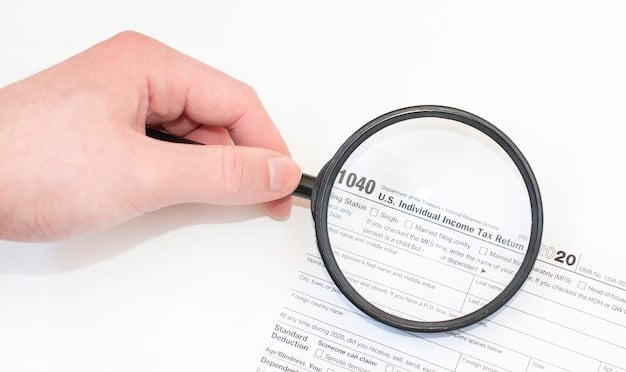Unlock Duty-Free Imports: A Step-by-Step Guide to Section 321

Unlocking Section 321 allows US importers to bring in goods valued at under $800 duty-free, streamlining customs processes and potentially reducing costs, making it a valuable tool for small businesses and individual consumers.
Navigating the world of international trade can seem daunting, but **unlocking Section 321: A Step-by-Step Guide to Duty-Free Imports Under $800 in the US** provides a streamlined way to import goods without incurring hefty duty fees. This guide provides a step-by-step approach to understanding and utilizing this beneficial provision.
Understanding Section 321: De Minimis Value
Section 321, often referred to as the “de minimis” rule, allows for the duty-free and tax-free importation of goods into the United States, provided their fair retail value does not exceed $800. This regulation significantly simplifies the customs process and can lead to substantial cost savings for importers, particularly those dealing with smaller, frequent shipments. This makes it a highly valuable tool for e-commerce businesses and individuals regularly importing goods.
The History and Purpose of Section 321
Originally designed to facilitate the processing of low-value shipments, Section 321 has evolved significantly over the years. Its primary goal remains to streamline customs procedures for goods that pose a minimal revenue risk to the government. Increased limits and updated guidelines have kept it relevant in the face of growing international trade.
Key Benefits for Importers
The core benefits of utilizing Section 321 include the elimination of duties and taxes on eligible shipments, reduced paperwork and simplified customs clearance, and faster processing times compared to traditional imports. These advantages can lead to lower overall costs and increased efficiency for businesses.
- Elimination of duties and taxes for eligible shipments.
- Simplified customs clearance process.
- Faster processing times.
- Reduced paperwork and bureaucratic overhead.
In summary, Section 321’s de minimis provision presents a considerable advantage for importers seeking to lower costs and expedite the movement of goods into the United States. By taking leveraging this opportunity is smart for businesses of all sizes.
Eligibility Criteria: What Qualifies for Section 321?
Not all imported goods qualify for Section 321. A clear adherence to specific conditions is essential. These parameters encompass the item’s declared value and nature. Also, a keen understanding of the various restrictions that could potentially impact approval.
Value Threshold: Staying Under $800
The most critical criterion is that the fair retail value of the goods being imported must not exceed $800. This valuation should be based on the price that the goods would fetch in the country of export, not necessarily the price paid by the importer. Accurate declaration is critical as assessed valuations are not based on actual prices paid.
Prohibited and Restricted Items
Certain categories of goods are explicitly excluded from Section 321 benefits. These typically include items subject to quotas, anti-dumping duties, or those restricted for health and safety reasons. Shipments containing firearms, ammunition, alcohol, tobacco, and certain agricultural products usually will not qualify.
Country of Origin Considerations
While Section 321 itself does not impose country-of-origin restrictions, other trade regulations and agreements may impact eligibility. Importers should verify whether any specific trade sanctions or embargoes apply to the country from which the goods are being imported.

- Goods must have a fair retail value of $800 or less.
- Certain items are prohibited, including alcohol and tobacco.
- Country of origin may be subject to other trade regulations.
Therefore, it is vital for importers to verify that their goods meet all eligibility criteria before attempting to claim Section 321 benefits. Compliance helps ensure that goods are admitted, duty-free and tax-free, without complications.
Step-by-Step Guide to Claiming Section 321 Benefits
The actual claiming of benefits from Section 321 requires several steps. Accuracy is very important, and this involves providing all required information to customs officials. The steps include preparing for import and ensuring that all goods meet requirements.
Preparing Your Shipment
Before shipping goods, ensure compliance with all relevant US Customs and Border Protection (CBP) regulations. Accurate record-keeping, proper labeling, and correct valuation of the goods are vital. A thorough understanding of the Harmonized Tariff Schedule (HTS) codes for the items being imported is also important.
Completing Customs Documentation
When importing under Section 321, you’ll need to complete a CBP Form 7501 (Entry Summary) or its electronic equivalent. The form requires information such as the shipper’s and consignee’s details, a description of the goods, their value, and the applicable HTS code. Mark the entry as a Section 321 shipment.
Working with Customs Brokers
Consider engaging the services of a licensed customs broker as they possess the expertise and knowledge to navigate the import process efficiently. Their mastery of customs regulations can prevent costly delays and errors.
- Ensure all shipping and labeling is correct, and up-to-date.
- Complete CBP Form 7501 or its digital counterpart.
- Consider consulting with customs experts during the process.
The process of claiming Section 321 duty-free import advantages benefits is straightforward. However, the importer should keep current on the best procedures available, and that all guidelines are adhered to.
Common Mistakes to Avoid When Using Section 321
Even if the Section 321 process appears streamlined and intuitive, some parties falter from these requirements. This is why it is important to take steps to manage them. Below are some errors to avoid during future transactions.
Incorrect Valuation
Understating or misrepresenting the value of goods is one common mistake. CBP imposes harsh penalties for undervaluing shipments, so it’s important to declare the fair retail value accurately. This usually involves a review of previous appraisals.
Misclassification of Goods
Assigning an incorrect HTS code to the imported goods can result in the incorrect assessment of duty rates and potential penalties. Double-check the HTS code and confirm that it is the most accurate classification for your items.
Not Declaring All Items in a Shipment
Ensure all items in a shipment are properly declared on the customs documentation. Failing to declare all items even if inadvertently, is going to lead to penalties and delays. Take your time as you work down the list, especially with the small stuff.

- Avoid undervaluing goods to avoid penalties.
- Double-check HTS codes for imports.
- Declare all items, no matter how small.
Avoiding these common mistakes will ensure a smooth and compliant Section 321 import process. This is going to reduce the chances of encountering regulatory hurdles or incurring costly penalties.
Maximizing the Benefits: Strategies for Importers
In addition to following all guidelines set forth there are certain things importers can do. Doing so increases the advantages of Section 321 and further reduces the overall costs. With smart planning these benefits increase.
Supplier Negotiation
Negotiating favorable pricing with your suppliers can maximize the number of shipments that fall under the $800 threshold. This ensures that goods remain eligible for duty-free entry under Section 321. This can also establish long-term relationships needed for more complex transactions.
Shipment Consolidation
Evaluate the possibility of consolidating multiple smaller shipments into one larger shipment to save on shipping costs. However, careful planning is required to ensure that the value of the consolidated shipment does not exceed the $800 limit.
Technology Solutions
Leverage technology solutions, such as automated customs declaration software, to streamline the import process. These apps lower administrative burdens, improve accuracy, and reduce the likelihood of errors. This can also serve as a compliance record.
- Talk to suppliers to get prices down.
- Consolidate separate orders.
- Manage everything with current digital solutions.
By adopting these strategies, importers can fully harness the benefits of Section 321. This enhances their competitiveness and streamlines their supply chain operations.
The Future of Section 321 and De Minimis Trade
The future of Section 321 remains in question, and is highly debated. This includes how they influence international trade. Discussions are being had at various levels of government as well as in the private domain.
Potential Changes and Updates
Changes to the de minimis threshold may be considered in response to concerns about revenue loss and potential abuse. However, any significant changes would likely face strong opposition from e-commerce retailers and consumers who benefit from the current regulations as the regulations are extremely popular.
Impact of E-Commerce Growth
The rapid growth of e-commerce has increased the significance of Section 321. Further growth in online retail is expected to keep pressure on policymakers to maintain or expand de minimis benefits to encourage global trade.
The Role of Technology
Advancements in technology will continue to transform the way goods are imported under Section 321. Automated customs clearance systems and enhanced data analytics may enable greater efficiency and help prevent abuse of the provision.
- Future changes are being debated, and are still unclear.
- E-commerce will push the issue one way or the other.
- Technology will drive change in customs.
The future of Section 321 is likely to be affected by ongoing debates. But it is anticipated to continue to serve a vital role in facilitating low-value trade. Importers, as a result, will continue to leverage its benefits.
| Key Point | Brief Description |
|---|---|
| 📦 De Minimis Value | Shipments valued under $800 are duty-free. |
| 🚫 Prohibited Items | Certain items like alcohol and firearms are excluded. |
| 📝 Accurate Documentation | Complete CBP Form 7501 with correct details. |
| 📈 Maximize Benefits | Negotiate pricing and consolidate shipments. |
Frequently Asked Questions
▼
Section 321 is a U.S. Customs and Border Protection regulation allowing duty-free and tax-free entry of goods valued at $800 or less. This is often referred to as the “de minimis” value.
▼
Goods subject to quotas, anti-dumping duties, or restricted for health and safety reasons are typically not eligible. This also includes firearms, ammunition, alcohol, and tobacco.
▼
Declare the fair retail value of the goods in the country of export. This is the price the goods would fetch in their origin country, not necessarily what you paid.
▼
CBP Form 7501 (Entry Summary) is required for importing goods under Section 321. It provides details about the shipment, including the shipper, consignee, description of goods, and their value.
▼
Yes, a licensed customs broker can provide assistance navigating customs regulations, completing paperwork, and ensuring compliance, which can help avoid delays and errors in your imports.
Conclusion
Mastering Section 321 is a vital step for those wanting to import duty-free into the United States. Complying with every regulation is important. Utilizing the strategies discussed will enhance productivity, reduce expenses, and improve your ability to thrive in today’s trade environment.





